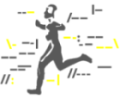





Search | Sitemap | Navigation |  |
|
||||||||||||||||||||||||||
|
||||||||||||||||||||||||||
|
||||||||||||||||||||||||||
|
| ICHD-II 1.3 |
1.2.6 Basilar-type migraine
Previously used terms:
Basilar artery migraine, basilar migraine
Description:
Migraine with aura symptoms clearly originating from the brainstem and/or from both hemispheres simultaneously affected, but no motor weakness.
Diagnostic criteria:
A. At least 2 attacks fulfilling criteria B-D
B. Aura consisting of at least two of the following fully reversible symptoms, but no motor weakness:
1. dysarthria
2. vertigo
3. tinnitus
4. hypacusia
5. diplopia
6. visual symptoms simultaneously in both temporal and nasal fields of both eyes
7. ataxia
8. decreased level of consciousness
9. simultaneously bilateral paraesthesias
C. At least one of the following:
1. at least one aura symptom develops gradually over 5 minutes and/or different aura symptoms occur in succession over 5 minutes
2. each aura symptom lasts 5 and 60 minutes
D. Headache fulfilling criteria B-D for 1.1 Migraine without aura begins during the aura or follows aura within 60 minutes
E. Not attributed to another disorder
Compendium taken from Cephalagia © International Headache Society 2003.
Author: Markus Dahlem
Last modification of this page: Wednesday March 16. 2005
| ICHD-II 1.3 |
 Top of the page
Top of the page| · | News |
| · | Medical Professionals |
| · | Medical Studies |
| · | Classification of visual disturbances |
| · | J.J. Ignatius Brennan |
| · | Mark Fitzgerald |
| · | Sickan |
Copyright © 2005 Migraine Aura Foundation, All rights reserved. Last modification of this site: August 25, 2006
Thanks to: RAFFELT MEDIENDESIGN and GNU software | webmaster@migraine-aura.org
http://migraine-aura.org/EN/ICHD-II_1.2.6_Basilar-type_migraine.html


